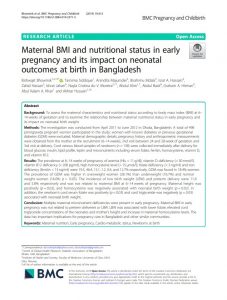
Background
To assess the maternal characteristics and nutritional status according to body mass index (BMI) at 6– 14weeks of gestation and to examine the relationship between maternal nutritional status in early pregnancy and its impact on neonatal birth weight.
Methods
The investigation was conducted from April 2011 to June 2012 in Dhaka, Bangladesh. A total of 498 primigravida pregnant women participated in the study; women with known diabetes or previous gestational diabetes (GDM) were excluded. Maternal demographic details, pregnancy history and anthropometric measurements were obtained from the mother at the recruitment (6–14weeks), 2nd visit between 24 and 28week of gestation and 3rd visit at delivery. Cord venous blood samples of newborns (n=138) were collected immediately after delivery for blood glucose, insulin, lipid profile, leptin and micronutrients including serum folate, ferritin, homocysteine, vitamin D, and vitamin B12.
Results
The prevalence at 6–14weeks of pregnancy of anemia (Hb, <11g/dl), vitamin D deficiency (<30nmol/l), vitamin B12 deficiency (<200pg/ml), high homocysteine level (>15μmol/l), folate deficiency (<3ng/ml) and iron deficiency (ferritin <13ng/ml) were 19.5, 46.4, 15.1, 1.2, 0.4, and 12.7% respectively. GDM was found in 18.4% women. The prevalence of GDM was higher in overweight women (28.1%) than underweight (16.7%) and normal weight women (16.0%: p< 0.05). The incidence of low birth weight (LBW) and preterm delivery were 11.6 and 5.8% respectively and was not related to maternal BMI at 6–14weeks of pregnancy. Maternal height was positively (p=0.02), and homocysteine was negatively associated with neonatal birth weight (p=0.02). In addition, the newborn’s cord serum folate was positively (p=0.03) and cord triglyceride was negatively (p=0.03) associated with neonatal birth weight.
Conclusion
Multiple maternal micronutrient deficiencies were present in early pregnancy. Maternal BMI in early pregnancy was not related to preterm deliveries or LBW. LBW was associated with lower folate, elevated cord triglyceride concentrations of the neonates and mother’s height and increase in maternal homocysteine levels. The data has important implications for pregnancy care in Bangladesh and other similar communities.